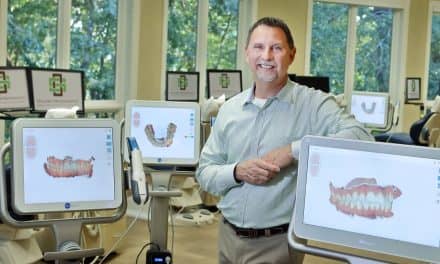Orthodontic Products asked a Grin user to document how the remote monitoring platform affected the practice workflow.
By C. Colby Gage, DMD, DHEd
Whether it’s in response to the COVID-19 pandemic or a way to differentiate, orthodontists are increasingly adopting remote monitoring solutions. Of all the remote monitoring tools I’ve used in my startup practice, LevelUp Orthodontics, in Parker, Colo, Grin is the only platform that drove significant practice growth by eliminating our pain points.
Pain points from the clinical perspective range from unproductive appointments due to lack of tooth movement or noncompliance to emergency appointments. From the practice efficiency perspective, orthodontists have long strived to balance patient appointments with dedicating more chair time for new patient consults that convert into immediate case starts.
Unsurprisingly, these pain points are interrelated and can be addressed by improving the patient experience through enhanced patient communication, customer service, transparency, and flexibility.
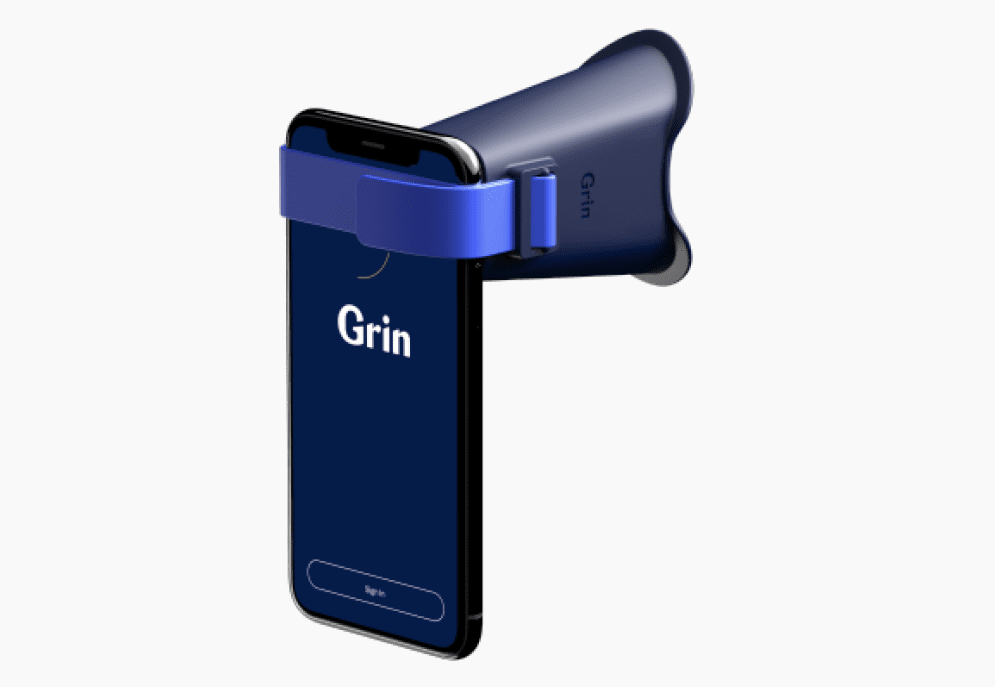
Grin is a digital orthodontic platform that provides remote monitoring solutions. Its software and technology devices suite are FDA listed and certified through Health Canada.
We’ve fully embraced Grin from consult to retention because it allows us to fulfill our brand promise to patients by cultivating the latest technology and orthodontic techniques to make the process of creating confident smiles comfortable and extremely effective for our patients.
But let’s be honest: Our industry can be slow to adapt to change because there’s often very little certainty that a technology will work and few examples of practical implementation. I hope that by providing a breakdown of how my team and I integrated Grin at LevelUp in February 2021, orthodontists will gain a greater understanding of how remote monitoring can drive practice growth.
Adopting the Grin Experience
Here’s how Grin works. Patients sign up for remote monitoring at our practice through the Grin App on their Apple or Android smartphone. We then give patients a Grin Scope that attaches to their smartphone, enabling them to take high-definition photos and videos of their teeth and bite. These images and videos produce full frontal, buccal, and intraoral occlusal views. The Grin Scope is an FDA-listed medical device.
From there, patients upload their Grin scans to the HIPAA compliant Grin App to monitor their hygiene, compliance, and treatment progress.
All communication between our practice and patients is conducted asynchronously through the Grin App on the patient side and the Grin Doctor Portal, a web-based interface with a suite of remote monitoring, communication, and consultation capabilities. I’ve trained our front desk personnel, treatment coordinator, and clinical assistants to review the scans and provide feedback to the patient about hygiene, compliance, and progress. We frequently calibrate as a team and review scans in the morning huddle to prepare for the day. The team also uses these scans to confirm that the patient is on track for their next in-person appointment. If not, we reschedule the appointment through the Grin App.
I also review all the scans and record Grin Scan Reviews when necessary to deliver a video message to patients with revised treatment plan instructions, reinforcement, or encouragement.
Streamlining Clinical and Operational Workflows
Since I enroll all of my patients into Grin, no matter which appliances I’m using to correct their smiles, I’ve updated my clinical and operational workflows to be seamless with the Grin platform. This includes everything from staff training and communication touchpoints to in-person appointment cadences and hygiene coaching. Our revised clinical protocols are shown in the following table.
| Before Grin | With Grin | |
| New Patient Consult | • Patient called the practice to schedule a consult • If beginning treatment after the consult, same-day starts were not always available • We had 12 available 60-minute appointment slots for consults per week • 75.8% conversion rate | • Patient requests virtual consult through practice’s website, which leads them to the Grin App • Either the treatment coordinator or Grin mails the patient a Grin Scope • Patient uploads the Grin scan • Orthodontist provides Grin Scan Review with clinical diagnosis and treatment plan • Treatment coordinator initiates follow up in Grin • We now have 18 extra available 60-minute new patient start appointments available per week • 88% conversion rate |
| First Appointment | • Bonding appointments, aligner fittings, attachments, 3D scanning • After the appointment with the orthodontist, the patient spends an additional 15 minutes watching a hygiene video • Total time: 60 minutes | • Bonding appointments, aligner fittings, attachments, 3D scanning • Treatment coordinator onboards patient to practice protocols and shows them how to download and use the Grin App • Patient provided a Grin Scope • Clinical assistant shows patient how to access oral hygiene instructions in the Grin App. • Templated messages on hygiene or aligner care are sent to the patient. • Clinical assistant demonstrates how to take Grin scan and ensures first scan is taken and uploaded • Total time: 60 minutes |
| Remote Monitoring | Not Applicable | Braces Patients • Upload Grin scan on bonding day and every 28 days Aligner Patients • Upload Grin scan every 1 to 2 weeks Carriere Motion / Elastics Patients • Scan every 28 days |
| In-Person Appointments | Braces Patients • Every 8 weeks Aligner Patients • Every 8 weeks Carriere Motion / Elastics Patients • Every 8 weeks | Braces Patients • Every 2.5 to 3.5 months Aligner Patients • IPR at tray 15 when needed • iTero scans when additional aligners are needed Carriere Motion / Elastics Patients • When we’ve achieved the desired correction |
| Retention | Retention checks at 1 month, 6 months and 12 months. | Upload Grin scan once a week for the first month; then scans on demand |
The efficiencies are evident in the Grin workflow with the most apparent being that we are only seeing patients in-person for bonding and debonding, 3D scanning, manual appliance adjustments, and IPR for aligner patients.
Since the Grin Scope provides high visibility of the patient’s bite and teeth, we’ve eliminated appointments that previously served only to assess patients’ progress, compliance, and hygiene. When patients come into the practice for appointments, we’re also confident that we’re going to be advancing their treatment, which eliminates disappointment and rescheduling due to non-compliance.
Grading Grin on 6 Key Metrics
We’ve defined the success of our Grin integration at LevelUp Orthodontics by six metrics that we tracked for the first 85 patients we enrolled in Grin.
- Care Calls Saved. It’s our goal to have at least one non-treatment-related and non-transactional check-in with patients. We’re now doing this through Grin’s messaging capabilities, which has saved the team an average of 1.9 care calls/follow-ups per patient.
- Appointments Scheduled or Rescheduled via the Grin App. When necessary, a third of patients scheduled or rescheduled their appointments using the Grin App, eliminating the back-and-forth phone calls and voicemails that often happen between the front desk team and patients.
- Appointment Reminder Calls Saved. Similarly, there’s less need to remind patients about their appointments, and we’ve had fewer no-shows because patients know that the appointments are purposeful and meaningful, not just progress checks.
- Emergency Visits Saved. We’re saving as many as three emergency visits per patient by addressing patients’ urgent concerns through Grin’s video messaging capabilities.
- Treatment Checks Saved. More than half of the patients had at least one appointment eliminated from their treatment cadence with the revised workflow and most skipped an additional appointment since we are monitoring them through Grin.
- Hygiene Reinforcements and Coaching Lessons Sent. Our team is sending comprehensive hygiene instructions and reinforcements via Grin, practically eliminating the need to spend time addressing this during in-person appointments. Since hygiene isn’t something we can address until we see the patient, we’re no longer delaying treatment because of poor oral hygiene.
Case Study of Grin-Enrolled Patient
In one example, streamlining processes at LevelUp Orthodontics through Grin enabled us to give a patient the smile he desired in 11 months with only five in-person appointments.
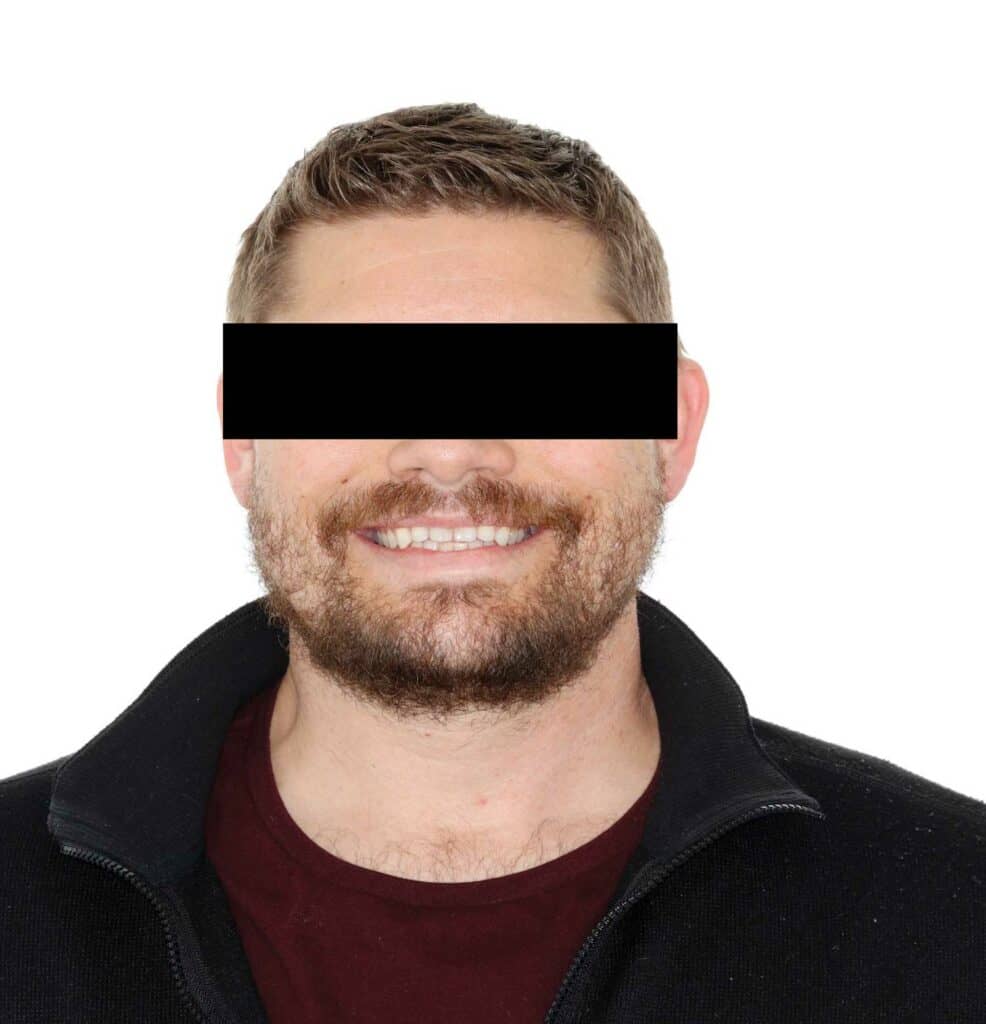

The 36-year-old male patient presented with increased incisor display and broadened arches. We estimated that his aligner treatment would take 12-14 months. We performed the initial consultation, obtained scans and records and submitted the prescription all in the same appointment.
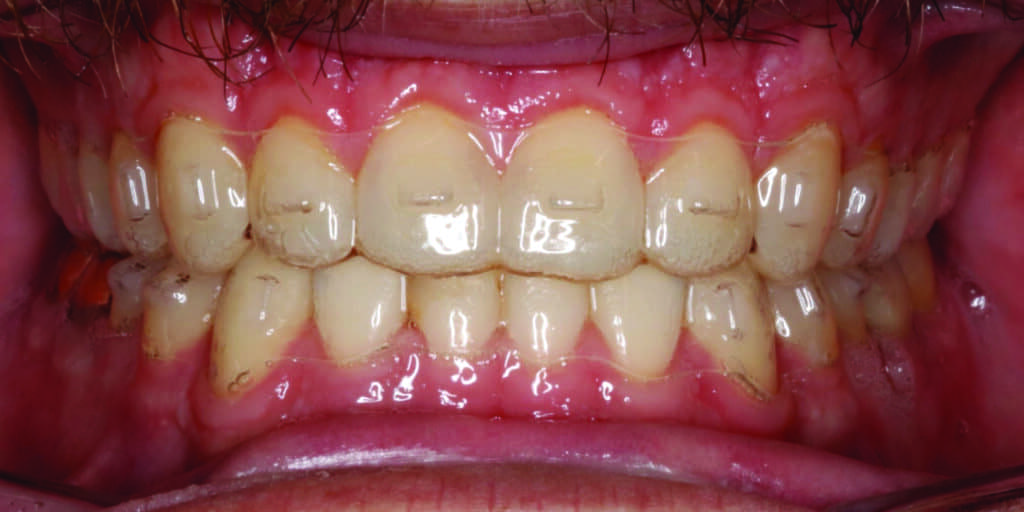

In March 2021, one month after the consult and case start, I gave the patient his set of 30 aligners (Spark Clear Aligners System from Ormco) and placed the attachments. I ensured the aligners fit properly and instructed the patient to wear each tray for 22 hours per day for one week prior to advancing to the next tray. The patient was also directed to upload a Grin scan every
2 weeks.
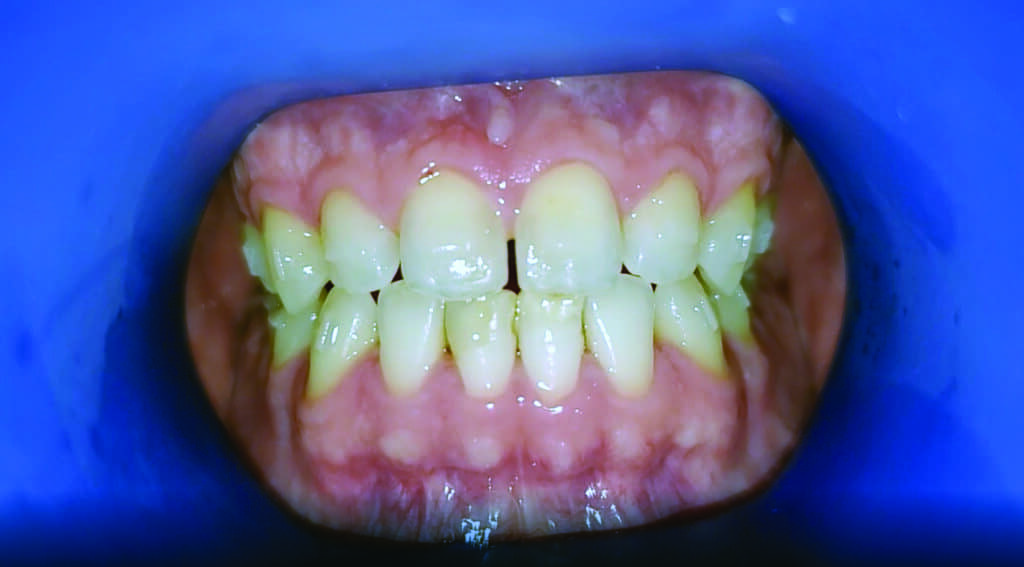
During the patient’s third in-person appointment 3 months later in June 2021, I performed IPR.
I conducted a STL scan for additional aligners during his fourth in-person appointment in September 2021 and performed enameloplasty. Since no additional IPR or attachments were planned, the patient picked up his aligners on a non-doctor day.
The patient came in for his fifth and final appointment in May 2022. We removed the attachments, scanned for retainers, obtained new records, and transitioned him to our Grin retention protocol. He picked up his retainers the next day.
Our use of Grin and Spark Aligners with this patient allowed us to decrease the number of extra aligners used and finish our treatment in less time. Every one of this patient’s in-person appointments was meaningful and required my orthodontic skillset and workmanship. The appointments were not merely progress or retention checks because we are now doing that through Grin, generating significantly more availability for consults, new patient case starts, and team training.
Embracing Change to Advance Orthodontics
By fully adopting Grin’s remote monitoring capabilities and their proprietary technology across the entire patient lifecycle, we realize efficiencies and practice growth that previously wasn’t possible. From consult to retention, Grin provides a better treatment experience for patients and clinical workflow for orthodontists. Grin equips orthodontists to deliver this type of experience to grow our practices and advance our industry. It’s up to us to embrace the change. OP
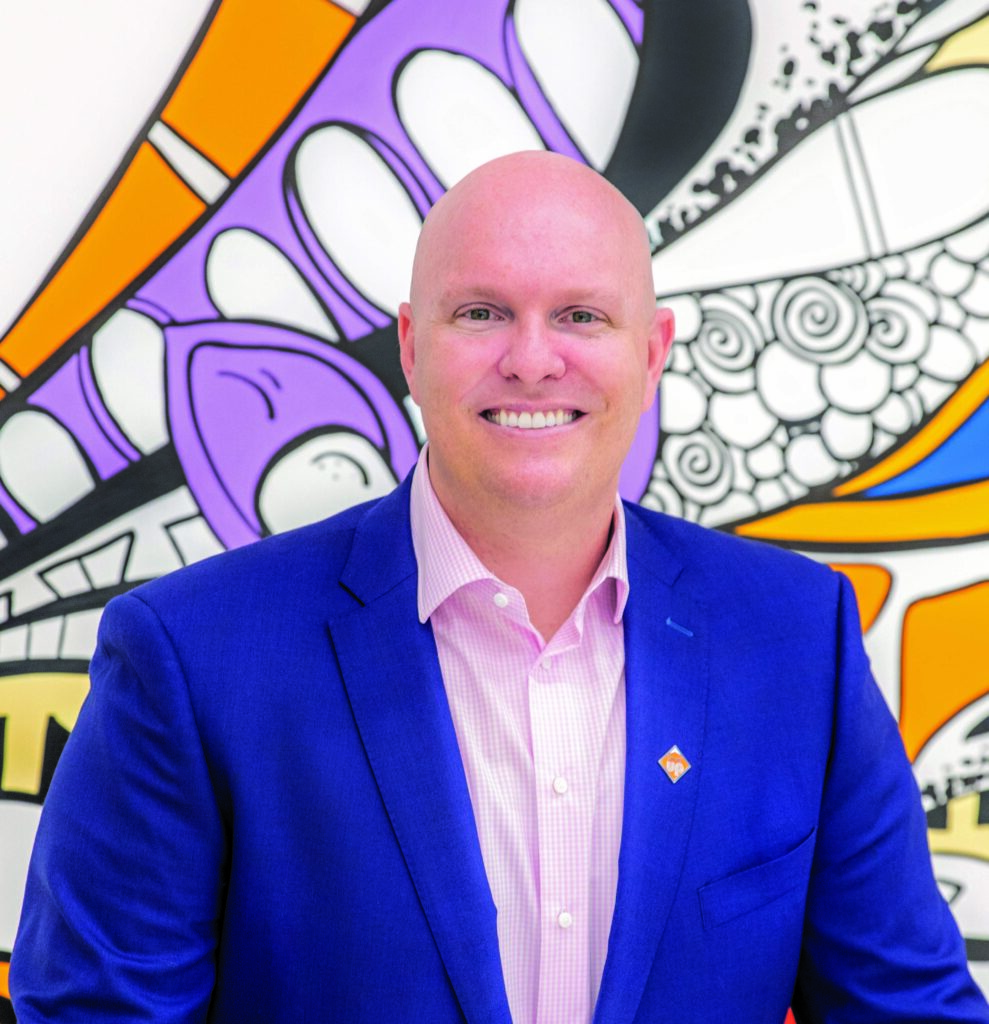
C. Colby Gage, DMD, DHEd, is a practicing orthodontist and teacher. He received his dental degree from Western University of Health Sciences in Pomona, Calif, and his certificate in orthodontics from A.T. Still University in Mesa, Ariz. He currently serves as assistant professor of orthodontics at Western University and is the owner of LevelUp Orthodontics in Parker, Colo.




